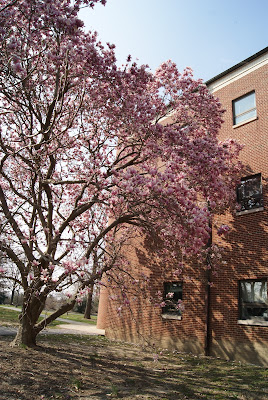 |
| Saucer Magnolia (Magnolia x soulangeana) outside of Worrilow Hall at the University of Delaware |
In the month when we would generally be expecting to see snowdrops and the earliest few daffodils flowering, we're instead greeted by cherries and magnolias in full bloom. The whole situation has me feeling a bit uneasy... maybe it's just that I grew up in New England, but I'm still fearing a late frost or snowstorm will decimate this premature spring landscape. A quick look at the extended forecast however shows no such thing, so maybe we're safe.
Were I still a full-time horticulturist, I'm sure I'd be feeling a further sense of panic as my busy season would be starting up far before I had planned, but now as a full-time student, maybe I can afford to take a relatively worry-free approach to the early arrival of the spring flora, and in particular my personal favorite, the magnolias.
Were I still a full-time horticulturist, I'm sure I'd be feeling a further sense of panic as my busy season would be starting up far before I had planned, but now as a full-time student, maybe I can afford to take a relatively worry-free approach to the early arrival of the spring flora, and in particular my personal favorite, the magnolias.
My interest in the genus began the first time I saw Magnolia macrophylla, a native summer-flowering species I'll discuss on this blog a bit later. I didn't pay as much attention to the spring flowering species until doing a year-round internship at the Polly Hill Arboretum, where one of my projects involved recording the flowering status of the magnolia collection on a weekly basis.

I was surprised to see the Magnolias burst into full flower so quickly this year, as I usually notice a solid gap between the time when the Star Magnolias (Magnolia stellata) start, and when the Saucer Magnolias join them. Though Magnolia biondii entered bloom about when expected, I recall seeing a few Star Magnolias breaking bud, then when I checked again a few days later a good half of the UD Magnolia collection was approaching full bloom.
Though I certainly enjoy the Star Magnolias, I find their flowers a bit flimsy in comparison to those species flowering later in the season, with the Saucer Magnolia one of the first to begin the trend. Maybe it's the size of the flowers (sometimes reaching 10" in diameter), or the way the thickness of the petals give the flower a more "solid" appearance than much of what else is in bloom this time of year.

I was surprised to see the Magnolias burst into full flower so quickly this year, as I usually notice a solid gap between the time when the Star Magnolias (Magnolia stellata) start, and when the Saucer Magnolias join them. Though Magnolia biondii entered bloom about when expected, I recall seeing a few Star Magnolias breaking bud, then when I checked again a few days later a good half of the UD Magnolia collection was approaching full bloom.
Though I certainly enjoy the Star Magnolias, I find their flowers a bit flimsy in comparison to those species flowering later in the season, with the Saucer Magnolia one of the first to begin the trend. Maybe it's the size of the flowers (sometimes reaching 10" in diameter), or the way the thickness of the petals give the flower a more "solid" appearance than much of what else is in bloom this time of year.
 The Saucer Magnolia is actually a hybrid between two asian species, the Yulan Magnolia (Magnolia denudata) and the Lily Magnolia (Magnolia liliiflora). The Yulan Magnolia was long cultivated in asia for its pure white flowers, and the Lily Magnolia is a shrubbier species with pink flowers. The offspring has found a home in our landscape, as is probably one of the two more commonly planted and easily recognizable of the spring-flowering Magnolias (the other being the Star Magnolia).
The Saucer Magnolia is actually a hybrid between two asian species, the Yulan Magnolia (Magnolia denudata) and the Lily Magnolia (Magnolia liliiflora). The Yulan Magnolia was long cultivated in asia for its pure white flowers, and the Lily Magnolia is a shrubbier species with pink flowers. The offspring has found a home in our landscape, as is probably one of the two more commonly planted and easily recognizable of the spring-flowering Magnolias (the other being the Star Magnolia). |
| Magnolia x soulangeana 'Sundew' |
All the above images are of the standard hybrid, but I also witnessed the cultivar 'Sundew', which based on what I just read at the Magnolia Society's Cultivar Checklist, is an older cultivar which may possibly have some relationship to Magnolia cambellii. It also appears to be somewhat uncommon, or at least I would assume so based on it's notable absence from Dirr's Manual of Woody Landscape Plants and Callaway's The World of Magnolias.
Took many pictures of magnolias on Saturday (with many more to come next week) so probably plenty more magnolia posts to come over the next few days. Next time I'll probably talk about Magnolia kobus and Magnolia x loebneri. Until then there's always plenty about Magnolias on the Magnolia Society's facebook page.


No comments:
Post a Comment